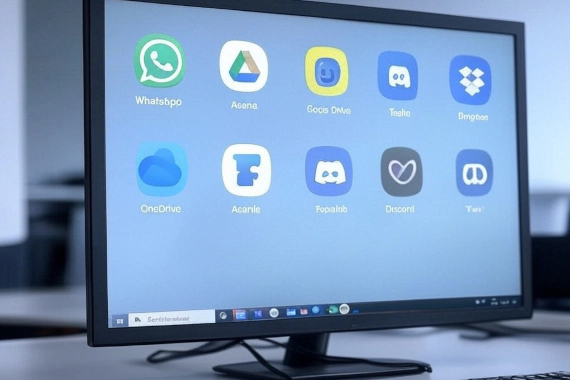
Creating a Shadow IT Policy: A Step-by-Step Guide
What is shadow IT and why is it a problem? Shadow IT refers to software that employees use for work without the …

Did you know that insider threats cause 60% of overall data breaches?
It’s true.
While malicious insiders seeking personal financial gain are the root cause for some of these, others stem from unintentional incidents or simply a lack of awareness.
Nonetheless, they are a serious threat to any organization.
In this article, we discuss data breaches caused by insider threats and provide you with some practical tips to help prevent these incidents.
But first, let’s reiterate…
The situation is really that bad.
As mentioned, the total number of data breaches caused by insiders amounts to about 60% of all cyber threats. And soon, I’ll show you some real-life examples of malicious insider threats.
But first, let’s look at the issue in a little more detail.
A data breach caused by an insider threat typically occurs when employees, contractors, or third-party business partners with legitimate access to an organization’s data misuse their access to steal, leak, or compromise sensitive information.
Note that I didn’t just say misuse. Although some data breaches happen due to deliberate or malicious activity by a disgruntled employee, there are actually five different types of insider threats.
At a high-level, insider threats can be split into two types: malicious and negligent. Having said that, there’s a bit more nuance to it than that.
1. The Negligent Insider: This group is often the most common type. It’s made up from employees who accidently create security risks through carelessness, poor security hygiene, or lack of awareness. These folks might fall for phishing scams, use weak passwords, or accidentally share sensitive data with unauthorized parties.
2. The Malicious Insider: This group deliberately wants to harm the organization. Their motivations can range from revenge for some perceived mistreatment to corporate espionage all the way to financial gain. This group is particularly dangerous because they often have legitimate access to sensitive systems. They may also have a deep understanding of your organization’s internal security defenses.
3. The Compromised Insider: This group represents a growing category. External attackers gain unauthorized access to employee credentials. This often happens through social engineering, infostealer malware, or phishing attacks. The compromised insider’s access can be exploited without their knowledge. This makes detection particularly challenging.
4. The Departing Employee: This group poses a unique risk during their transition out of the organization. Studies show a significant percentage of employees take proprietary data when leaving their jobs, whether for competitive advantage at their next position or as an “insurance policy.” This includes both voluntary departures and terminated employees.
5. The Third-Party Insider: The final group includes contractors, vendors, and business partners who have privileged access to your systems or data. While not direct employees, they can pose similar or even greater risks due to potentially lower security standards and accountability structures.
Overall, any type of insider threat can have severe consequences. Companies with insider threats experience financial loss, reputational damage, and loss of customer trust.
Unfortunately, it gets worse. These incidents are becoming more and more common for organizations. For example, the number of such incidents has risen by 47 percent since 2018, while their cost has increased by 31 percent in the same time period.
Insider threats represent one of the most expensive and damaging forms of data breaches organizations face today.
The average cost of an insider incident has climbed to over $15.4 million, with some cases exceeding $100 million in direct and indirect damages.
The financial impact stems from multiple vectors.
There are the immediate costs, which include incident response, forensics investigations, and system remediation.
Organizations typically spend 6-12 months containing and investigating a single insider incident.
Legal and regulatory compliance costs follow, especially in cases involving customer data exposure or intellectual property theft.
However, the most severe impact is often the long-term impact on the business.
When employees or contractors cause a data breach, organizations suffer reputational damage that can persist for years.
Customer trust erodes, leading to increased churn and difficulty acquiring new business.
For public companies, stock prices typically drop 7-15% following disclosures of major insider incidents.
The human cost is equally significant. Teams experience decreased morale and productivity in the aftermath.
Workplace culture often becomes more restrictive and less collaborative due to organizations implementing stricter controls.
Key employees may leave, viewing the increased oversight as a sign of distrust.
Industry data shows certain sectors face disproportionate insider risk.
Financial services, healthcare, and tech companies report the highest per-incident costs, likely due to their valuable IP and regulated data.
However, no industry is immune. Even manufacturing, retail, and government agencies report rising insider threat costs.
Prevention is far less expensive than remediation.
Organizations that invest in insider threat programs, including behavior monitoring, access controls, and compromised credential monitoring, spend 33% less on average when incidents occur.
Let’s look at some real-life examples.
In 2023, Tesla, the vehicle manufacturer, suffered a data breach that turned out to have been orchestrated by two former employees. These now external threat actors leaked sensitive personal data of 75,000 current and former employees, including their names, addresses, phone numbers, and social security numbers, from the company’s systems to a foreign media outlet.
In 2020, Twitter suffered a massive data breach (which has become one of the most famous insider threat cases) when hackers gained access to 130 private and corporate accounts (including Elon Musk, Jeff Bezos, or Bill Gates) and used those to promote a Bitcoin scam.
But at the heart of the attack was a simple oversight of the company’s security protocols. To orchestrate the attack, hackers targeted Twitter employees working from home. Disguising themselves as the company’s IT team, they tricked the employees into providing them with user credentials, and the rest is history.
Waymo's data breach certainly makes an interesting story. It centers around the company’s lead engineer, who in 2016 left the company to form a competitive business. Several months later, Uber acquired his business. But as it later turned out, what Uber acquired was, in fact, trade secrets that the employee, Anthony Levandowski, actually stole from his former employer.
Incredible, right?
But here’s the thing: can you actually prevent an insider data breach? Is there anything you could do to mitigate such risk?
There is. In fact, there are several things you can do.
Let’s look at them now.
The problem with data breaches is that they’re often impossible to detect right away. In fact, many companies learn about being victims of a data breach months or even years after the incident.
At the same time, detecting a breach right away means that you can take action to secure your data, and reduce the impact of the breach.
Software like Breachsense (disclaimer - this is our company) allows you to monitor for potential threats in real-time and detect data breaches the moment they happen.
This lets you revoke access, change passwords, and prevent cyber attacks before they happen.
Want to see Breachsense in action? Book a demo today.
Another method of preventing data breaches caused by insider threats is to limit access to sensitive data by granting permissions based on an employee’s job responsibilities.
This way, you can ensure that employees only have access to the information necessary for their role.
Naturally, this will not stop anyone with access to leak or steal the data. But it certainly limits the number of potential people who might get tempted to do so.
This one may seem like a no-brainer, but it truly is a powerful way to prevent insider threats, particularly those caused by negligence.
Provide ongoing security awareness training to educate employees about potential threats and best practices for maintaining data security.
Educate your employees on common ways hackers trick them into downloading malware
Train your staff on social engineering techniques designed to trick them into revealing sensitive information.
Teach employees to spot malicious emails and links in phishing attacks.
Help them understand how to keep their devices secure at all times.
Implement user behavior analytics and network anomaly detection along with other anomaly-based monitoring tools to detect suspicious activities and various types of insider threats.
This is yet another method that could signal a potential data threat early and allow your company to take immediate action to mitigate the issue.
Develop and enforce security policies that outline employees’ responsibilities for protecting sensitive data and the consequences of non-compliance.
Conduct thorough background checks on potential employees, contractors, and third-party partners to identify any red flags or potential risks.
Utilize DLP solutions to detect and prevent unauthorized data transfers, as well as ongoing dark web monitoring to ensure your data hasn’t leaked.
Create an anonymous reporting system that enables employees to report concerns or suspicious activities without fear of retaliation.
Periodically assess your organization’s security posture to identify potential vulnerabilities and areas for improvement.
Create a comprehensive incident response plan to ensure your organization is prepared to address insider threat data breaches quickly and effectively.
Data breaches caused by insider threats are a significant concern for organizations. Being proactive goes long way in preventing these incidents and minimizing their potential impact.
By implementing access controls, monitoring data breaches, and providing regular security training, organizations can better protect their sensitive data from insider threats.

What is shadow IT and why is it a problem? Shadow IT refers to software that employees use for work without the …

What are the Risks of Shadow IT When it comes to Shadow IT, there are five primary risks that it introduces into …